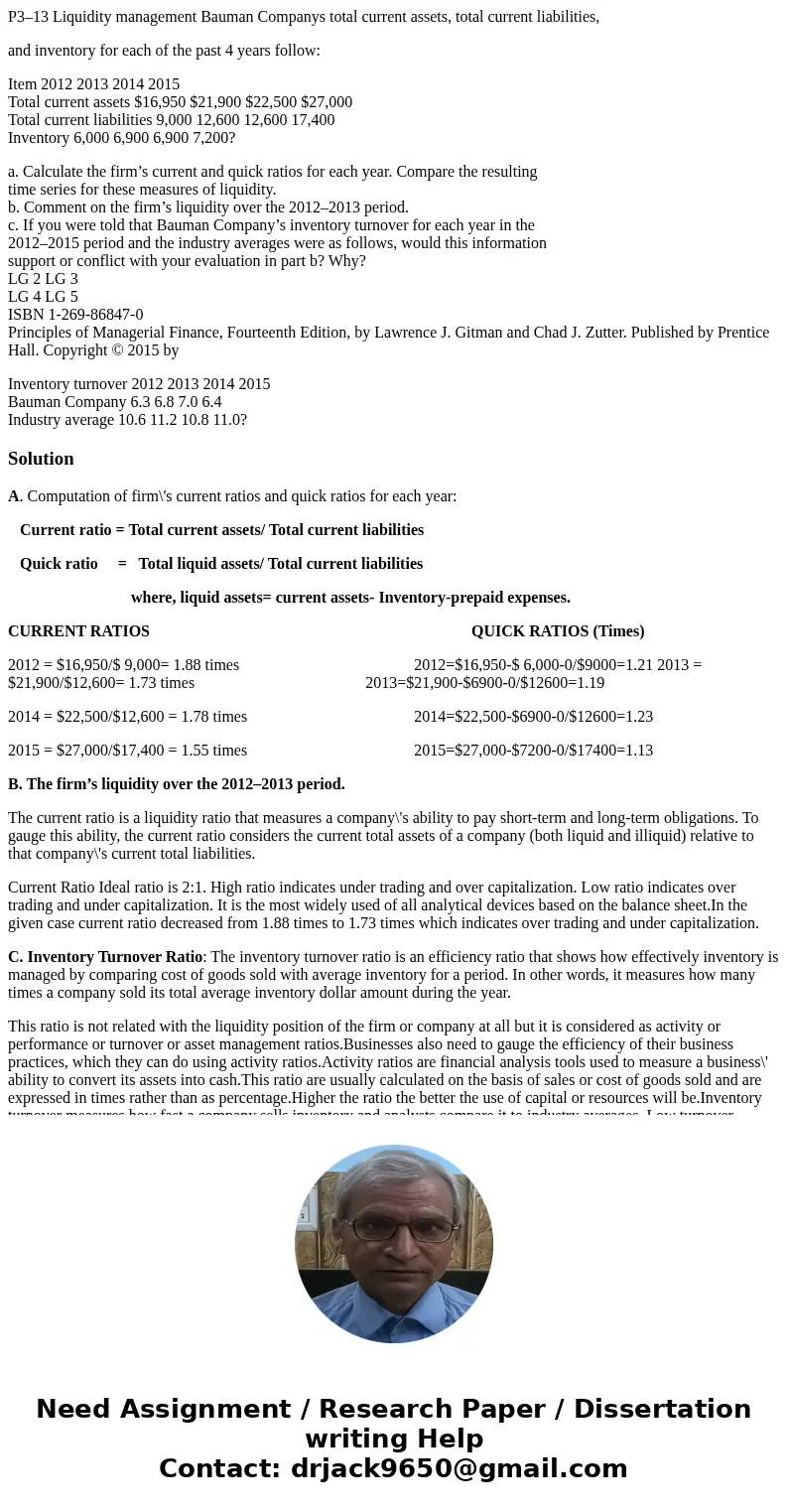P313 Liquidity management Bauman Companys total current asse
P3–13 Liquidity management Bauman Companys total current assets, total current liabilities,
and inventory for each of the past 4 years follow:
Item 2012 2013 2014 2015
Total current assets $16,950 $21,900 $22,500 $27,000
Total current liabilities 9,000 12,600 12,600 17,400
Inventory 6,000 6,900 6,900 7,200?
a. Calculate the firm’s current and quick ratios for each year. Compare the resulting
time series for these measures of liquidity.
b. Comment on the firm’s liquidity over the 2012–2013 period.
c. If you were told that Bauman Company’s inventory turnover for each year in the
2012–2015 period and the industry averages were as follows, would this information
support or conflict with your evaluation in part b? Why?
LG 2 LG 3
LG 4 LG 5
ISBN 1-269-86847-0
Principles of Managerial Finance, Fourteenth Edition, by Lawrence J. Gitman and Chad J. Zutter. Published by Prentice Hall. Copyright © 2015 by
Inventory turnover 2012 2013 2014 2015
Bauman Company 6.3 6.8 7.0 6.4
Industry average 10.6 11.2 10.8 11.0?
Solution
A. Computation of firm\'s current ratios and quick ratios for each year:
Current ratio = Total current assets/ Total current liabilities
Quick ratio = Total liquid assets/ Total current liabilities
where, liquid assets= current assets- Inventory-prepaid expenses.
CURRENT RATIOS QUICK RATIOS (Times)
2012 = $16,950/$ 9,000= 1.88 times 2012=$16,950-$ 6,000-0/$9000=1.21 2013 = $21,900/$12,600= 1.73 times 2013=$21,900-$6900-0/$12600=1.19
2014 = $22,500/$12,600 = 1.78 times 2014=$22,500-$6900-0/$12600=1.23
2015 = $27,000/$17,400 = 1.55 times 2015=$27,000-$7200-0/$17400=1.13
B. The firm’s liquidity over the 2012–2013 period.
The current ratio is a liquidity ratio that measures a company\'s ability to pay short-term and long-term obligations. To gauge this ability, the current ratio considers the current total assets of a company (both liquid and illiquid) relative to that company\'s current total liabilities.
Current Ratio Ideal ratio is 2:1. High ratio indicates under trading and over capitalization. Low ratio indicates over trading and under capitalization. It is the most widely used of all analytical devices based on the balance sheet.In the given case current ratio decreased from 1.88 times to 1.73 times which indicates over trading and under capitalization.
C. Inventory Turnover Ratio: The inventory turnover ratio is an efficiency ratio that shows how effectively inventory is managed by comparing cost of goods sold with average inventory for a period. In other words, it measures how many times a company sold its total average inventory dollar amount during the year.
This ratio is not related with the liquidity position of the firm or company at all but it is considered as activity or performance or turnover or asset management ratios.Businesses also need to gauge the efficiency of their business practices, which they can do using activity ratios.Activity ratios are financial analysis tools used to measure a business\' ability to convert its assets into cash.This ratio are usually calculated on the basis of sales or cost of goods sold and are expressed in times rather than as percentage.Higher the ratio the better the use of capital or resources will be.Inventory turnover measures how fast a company sells inventory and analysts compare it to industry averages. Low turnover implies weak sales and, excess inventory. A high ratio implies either strong sales or large discounts.

 Homework Sourse
Homework Sourse